End of an era: Maserati’s V8 bows out in the fastest saloon in the world
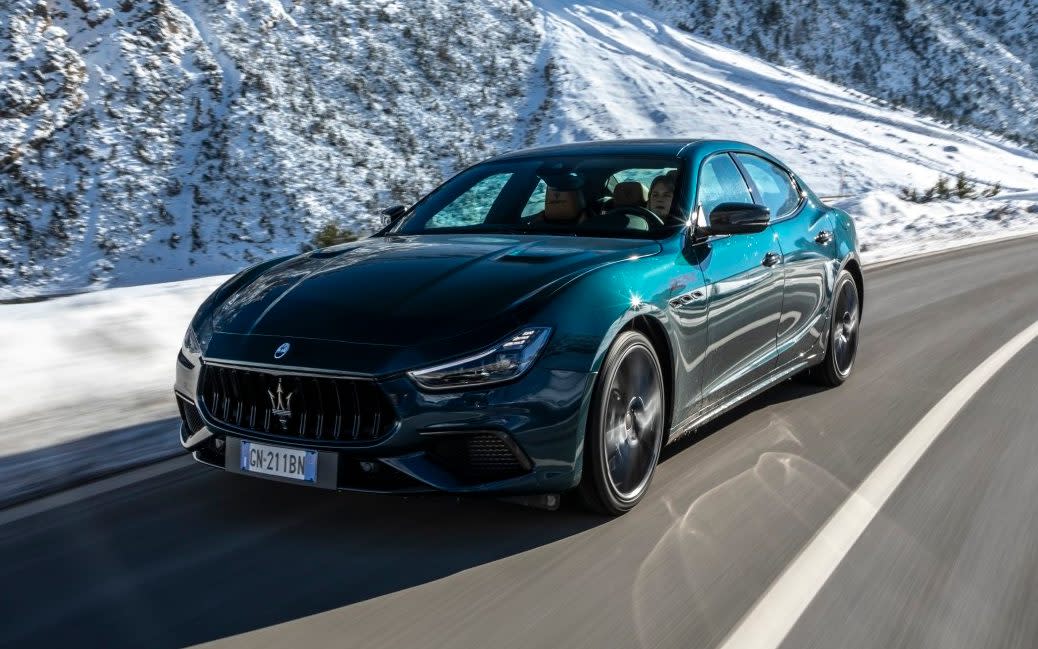
The sun is just setting over the peaks that seemingly encircle the village of Bormio. In the centre, the church is doused in a bright blue glow, with animated snowflakes played across its steeple.
The higgledy buildings that line the old cobbled streets are wreathed with twinkling, sparkling lights, while wedges of hard-packed snow at the street corners lay as testament to the freezing temperatures seen here in the past few days.
Bormio nestles in the Valtellina valley; first made famous for its thermal baths, which have existed for more than 2,000 years, having been discovered and popularised by the Romans.
Today, it is better known by skiers as a resort blessed with reliable snow on its north-facing slopes, and among cyclists as the gateway to the famous Stelvio Pass, a testing climb of 1,832 vertical metres that makes up part of the Giro d’Italia.
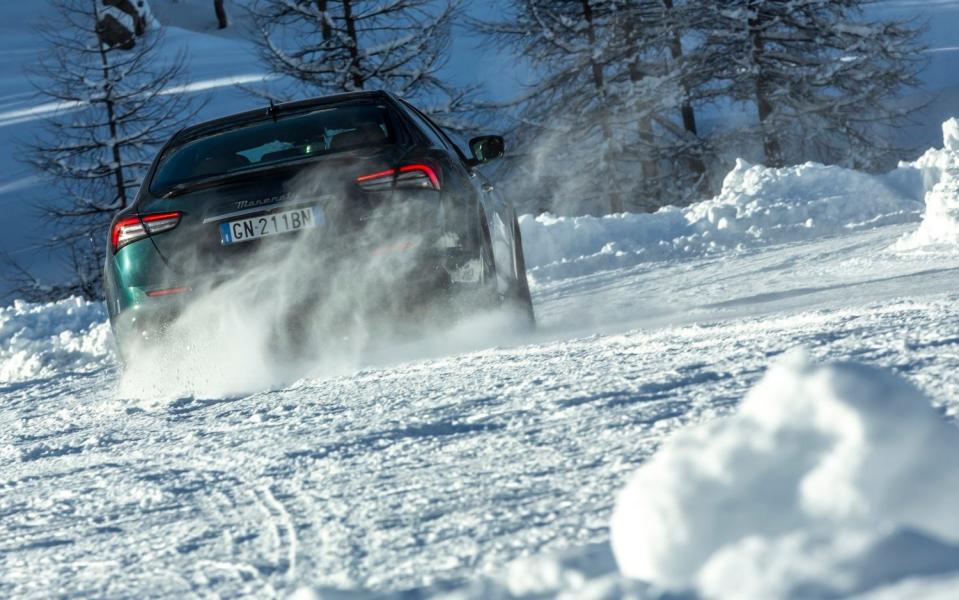
Our destination tomorrow will be one of the other four passes that once made this pretty little town such an important staging post; the Foscagno, which will take us over the mountains to Livigno. And not by bicycle either; we’ll be using something with a few more horsepower.
For we’re here with Maserati; a valedictory celebration, the PR department is billing it, of the V8 engine – its current iteration of which is likely to be Maserati’s last.
Say hello, wave goodbye
To commemorate that fact, there’s a new model: the Ghibli 334 Ultima, named after its maximum speed in kilometres per hour. That’s 208mph. There’s only one example available to test, however, so it’s likely to be a bunfight between the British, German and Canadian journalists present to get the keys.
Joining it are a slew of Ghiblis, Quattroportes and Levantes, all in Trofeo form and equipped with thumping great V8s, as well as the car we’re nominally here to drive: the new GranTurismos, conspicuously not V8-powered, but representing Maserati’s future direction.
The next morning, with the sun turning the tops of the mountains golden, more good news: along with another British journalist, I’ve managed to bag the Ghibli 334 as our first drive of the day. To create this car, Maserati has essentially taken its BMW M5-rivalling mid-range hot rod, the Ghibli Trofeo, and added lighter wheels, fancier tyres and a carbon pack. That’s it – the suspension, steering, even the 572bhp V8 engine remain untouched.
The result is a 5mph increase in the top speed of the already rapid Ghibli Trofeo, to 208mph, enough to allow it to pip the 207mph Bentley Flying Spur Speed to the title of the fastest factory four-door saloon in the world. Only 103 will be built, at a thunderous asking price of £159,625. Crikey.
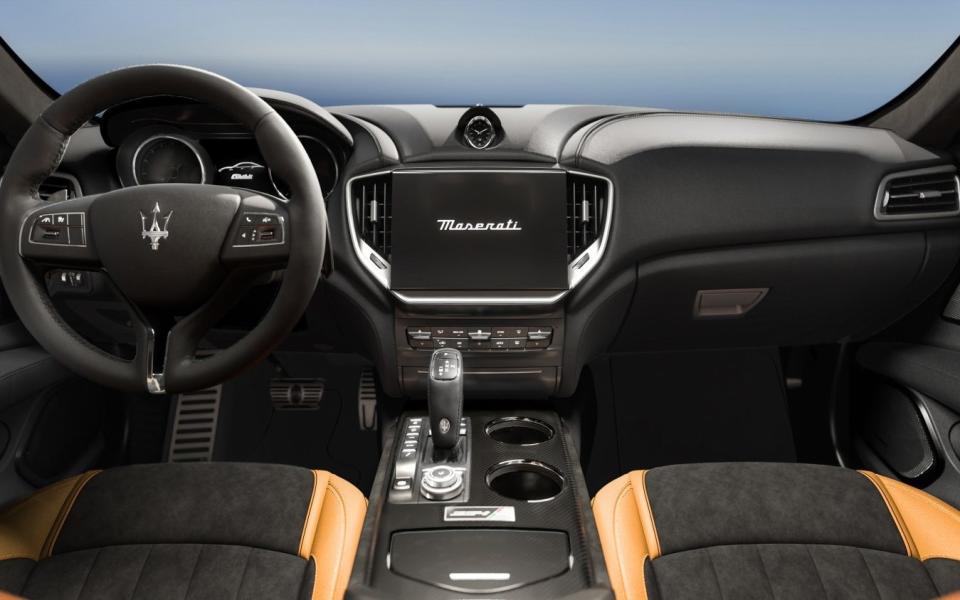
If you were thinking Maserati has some brass neck asking £50,000 more than the price of a standard Trofeo for what amounts to a new set of rims, fresh interior appointments, a swanky paint job and some carbon-fibre trim, it would be hard to argue.
Granted, this is a car that melts your cynicism to some extent when you get up close; that gorgeous colour scheme and the sumptuous leather trim really make it feel special.
But as you look it over, it’s impossible to silence the alarm wailing in your head, accompanied by a big red flashing sign in your mind’s eye, that screams “One hundred and fifty grand”. Sadly, the Ghibli 334 never comes close to feeling worth that sum.
Snow joke
Surely it’s pretty special on the road though? Well, I’d love to tell you. Sadly, as we file out of Bormio obediently in a follow-the-leader train of cars, mandated by Maserati’s PR team, it seems we won’t get much of a chance to find out.
Eventually, we manage to slip the surly bonds of the procession, but to no avail; as we leave Bormio itself, we find that the roads beyond are covered in a thick layer of slush and ice.
Even with the traction control fully engaged and the legally mandated winter tyres, anything more than very careful application of the accelerator pedal out of the many and varied hairpins sends the Ghibli’s tail sliding out.
So it continues for the next hour or so, any sort of evaluation of this car’s dynamic abilities off the cards as we stare enviously at locals in their Fiat Panda 4x4s. We console ourselves with the thought that, even at low speeds, the V8’s soundtrack is a delight.
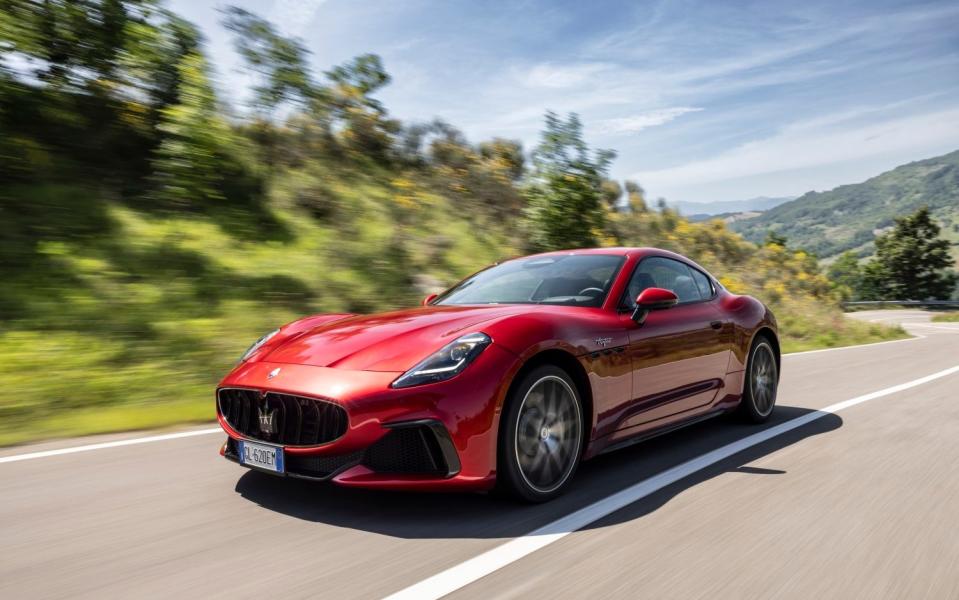
Eventually, we tiptoe into our destination at the other end of the Foscagno: Livigno – more specifically, the Ghiacciodromo Livigno, an ice driving track more usually populated by Subaru Imprezas and Mitsubishi Lancer Evolutions. Today, however, Maserati has hired the whole place and it’ll be Ghibli and GranTurismo Trofeos populating the ice instead.
In these two cars, you really can feel a step change; a clear line between the Maserati of 10 years ago and the Maserati of now, most likely a result of the £1.4 billion investment in the marque touted in 2019 by owner FCA, now part of the huge Stellantis conglomerate.
The results are plain: not just the new GranTurismo and its Nettuno twin-turbo V6 engine, but also the MC20 sports car, which shares this engine. Sadly, it also means Maserati’s V8 will breathe its last when this generation of Ghibli and Quattroporte cease.
Old stager
It’s no surprise, then, that the Ghibli now feels very old school. That’s not necessarily a bad thing, however; on the ice, the eight-cylinder gurgles and growls and once again, as the tail swings wide, it does so predictably and progressively.
It’s a very analogue car in a world that’s gone digital, and it’s fun, of course – but as we’ve just discovered, this is not a car whose performance one can extract if the Tarmac is anything less than bone dry.
The GranTurismo, on the other hand, is less fun on the ice. It’s four-wheel drive, for one thing, which means you’re constantly trying to overcome the car’s tendency to shuffle power to the front wheels; a boot-load of right foot is needed to get it sideways, then judicious feathering to keep it there, finding a balance between overcooking it and allowing the car to right itself.
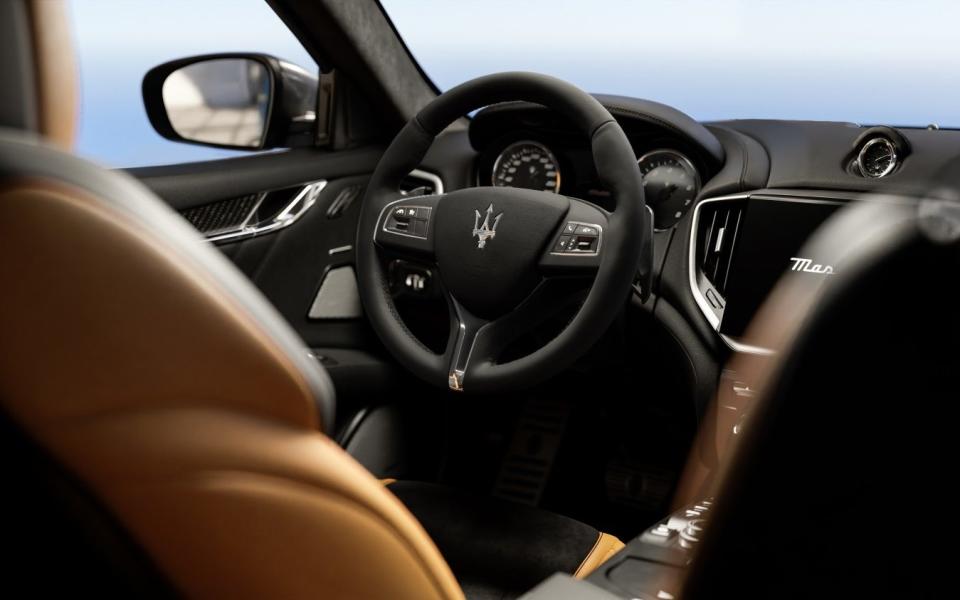
Of course, most GranTurismo owners won’t have an ice track to play with; in that context, its disadvantages on the ice will likely be advantages on a public road.
I attempt to confirm that theory. Livigno is surrounded on almost every side by the Swiss border, so if you want to stay in Italy there’s only one road in and out, the one we drove in on. So with little choice, I head back up the Foscagno pass, mindful of the slippery conditions and resigned to the fact I’ll have to forgo a proper road test for now.
Even so, you can get a better sense of the GranTurismo here, largely thanks to its traction advantage; even though I barely get above 40mph, it’s possible to tell that this is a car possessed of a delightfully supple ride, a beautifully balanced chassis and very direct steering.
Inside, too, it’s well executed; yes, were we to split hairs, then some of the switchgear could be higher quality, but for the most part the GranTurismo feels every bit as special as – perhaps more so than – the Ghibli 334 we were driving earlier.
Rear entry
It’s a proper grand tourer, too; there’s space in the back for me to sit comfortably behind my own driving position. That’s quite a feat when you consider how svelte the GranTurismo looks and together with the huge boot and Isofix points it means this is a car in which you really could seat four for a cross-continental journey.
The only other large coupe about which you really can say that these days is the Bentley Continental GT, which costs at least £20,000 more; there’s Aston Martin’s DB11 too, of course, which is similar money, but it’s a smaller car, and consequently feels less spacious in the back.
Having said that, it’d be disingenuous to paint the GranTurismo as a value option; the 542bhp Trofeo starts at £163,470 (you can save £30,000 if you’re prepared to put up with the mere 483bhp of the entry-level Modena version), but whether it’s because of the higher-quality cockpit or the slinky coupe styling, the GranTurismo somehow feels more “worth it” than the Ghibli 334 – despite the lack of that glorious V8 engine.
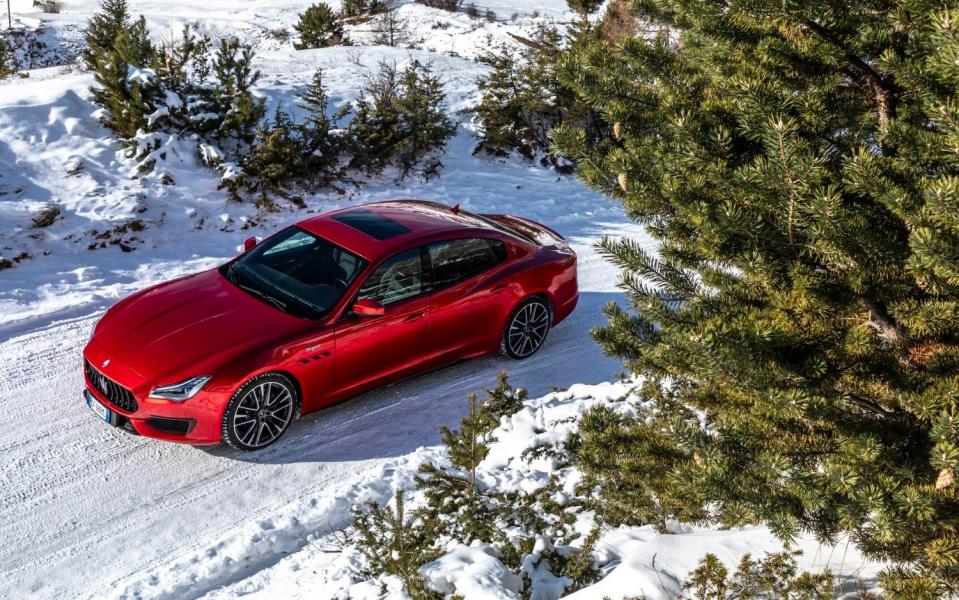
For all that, though, the Nettuno V6 is no less characterful, singing out with a glorious wail on the (very) rare occasions I get to extend it. And the GranTurismo’s low-speed docility makes it feel very usable in such treacherous conditions – something that can’t be said for the Ghibli.
For the return leg to Bormio we take a Quattroporte Trofeo. I’m not expecting great shakes; if ever there was a car that was the definition of an also-ran, this is it.
Not even BMW has tried to make a full-blown performance version of its luxury limousine, but that’s exactly what the Quattroporte Trofeo is; a large, long-wheelbase saloon with the Ghibli Trofeo’s 572bhp V8 wedged into the nose, giving a 0-62mph time of 4.5 seconds. It’s a combination that isn’t exactly in high demand – as evidenced by the fact that, since its introduction to the UK market in 2021, only nine have found homes.
Surprise and delight
Once again, the first part of the Foscagno is dispatched with some timidity. But as the tops of the mountains start to turn pink against a crystal sky and the road drops toward Bormio, we find the afternoon sun has melted the slush and evaporated the residual dampness, and – praise be – patches of dry Tarmac are emerging.
Here, the Quattroporte feels tremendous. Yes, its interior feels dated now, its satnav software and switchgear rather more crude than you’d expect in a car costing the best part of £135,000.
But ignore all that for a second. Look outside instead. For this is one of those cars that offers a brilliant view out, all swelling bodywork and lusty vents. And despite its not-inconsiderable length and breadth, the Quattroporte seems to shed bulk when you’re pressing on, snicking deftly round bends, with the lightest of touches, feeling like a car of half its weight.
The extra length in the chassis means it isn’t quite as tail-happy as the Ghibli, too, so while it will still offer easy powerslides given half the chance, you’ll find it easier to catch them – an important point when you didn’t quite anticipate one.
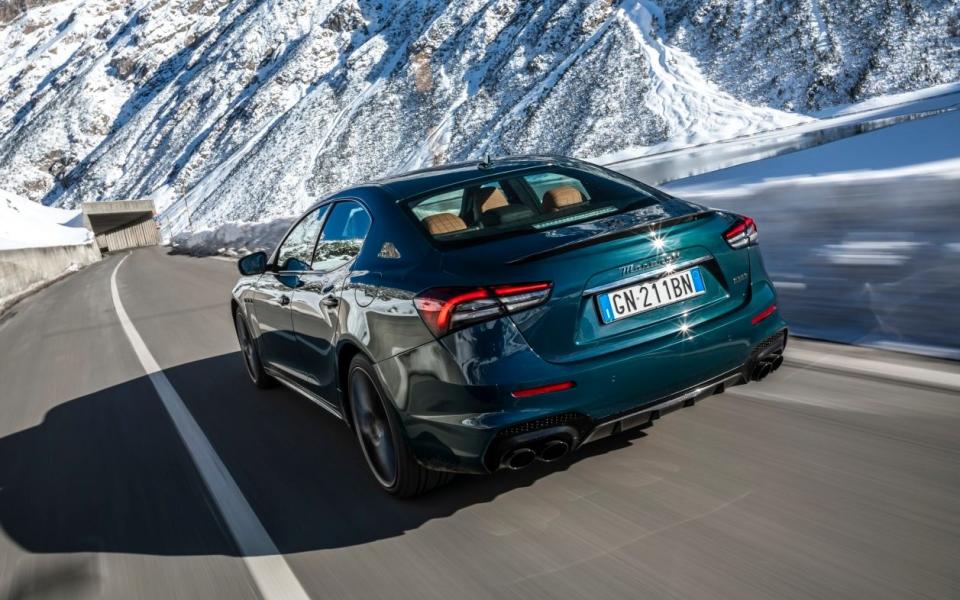
And the backing track for the whole experience is that glorious V8, spinning happily up to the red line as though it were a race engine, its exhaust wailing and howling with glee. The Quattroporte Trofeo may feel a little past it in places, but it certainly won’t go gentle into that good night.
Like the Ghibli 334, however, it is very difficult to recommend. Both of these cars simply cost too much and, given those prices, they simply don’t feel upmarket enough inside. There’s an overriding sense with both of an Alfa Romeo with ideas above its station; cars that are always two steps behind the real premium players in this market.
But Alfa Romeos are emotive cars, ones you buy with your heart instead of your head, and so it goes with these Maseratis. And while their prices are hard, nay impossible, to justify, it’s difficult not to come away with some affection for them.
The Quattroporte in particular, against all odds. The idea of spending £135,000 on one feels somehow more palatable – just – than the £20,000 extra you’d need for a Ghibli 334. Indeed, I find myself boarding the bus back to the airport feeling surprisingly envious of those nine people who now find themselves the owners of something rather flawed, but nevertheless very special – not to mention ridiculously exclusive.
It is, if nothing else, a fitting coda for Maserati’s relationship with the V8 engine, one which started way back in 1935 with the company’s Ruote Indipendenti racer, and one which will rightly be mourned.
If cars like the new GranTurismo are anything to go by, Maserati’s future looks bright. But sometimes, just sometimes, there’s something to be said for doing things the old-fashioned way.

